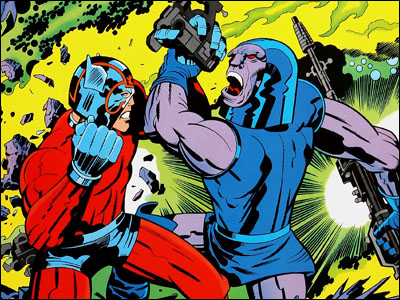The other day in this message, I solicited questions for this blog and got a lot of good ones, thank you very muchly. Keep 'em coming. Today, to distract myself from writing any more about Donald Trump, here's a question I received from Carl Croom…
I always loved the detail Jack drew in his comics. How did the colorists, or others who had to work on his drawings, feel about having to deal with it. Did anyone ever try to get him to change his style?
Well, a few of the inkers who had to turn his penciled art into inked art dealt with it by leaving things out and simplifying. It is quite possible for an inker to improve art that way but that can also be a nice excuse for not spending as much time on a page as you could or maybe should have.
With the colorists…well, if you have to color an intricate machine, you can expend the effort necessary to color each part of that machine separately or you can just color the whole thing light purple in one or two strokes of the brush. Some opted for the former, some opted for the latter and some weren't given the time to do the former so they had to do the latter. In the days before computer coloring of comic books, the colorists were paid quite poorly and were often expected to color entire issues overnight.

There's a whole debate which occasionally pops up in the industry about how much effort one should put into one's work with respect to the page rate. Ideally, a devoted artist will spend as much time on a page as he or she feels is necessary. Alas, that devotion can be exploited. Publishers can and sometimes do think, "Hey, we don't have to pay that guy too much. He'll work his butt off no matter how much we give him." For the most part though, Jack's best inkers — guys like Mike Royer, Joe Sinnott, Frank Giacoia, Chic Stone, Bill Everett and others — loved the work that was entrusted to them and worked real, real hard (regardless of compensation) to do justice to it.
Jack did have at least one inker who urged him to simplify his pencils and Jack responded by getting that inker removed from the assignment. For the most part though, pressure on Kirby to change his style came from editors and especially the folks in DC Production Department when he worked for that company. It was never a matter of how much detail he put into a page. As far as Management in comics was concerned, the artists should spend as much time on every page as possible as long as they met their deadlines. But there were those who didn't like that Jack drew like Jack with all the eccentricities that comprised his style.
At DC back then, they wanted more polish and realism, and they often spoke of a "company look," which meant having all the artists drawing somewhat alike. In 1970, my then-partner Steve Sherman and I paid our first visit to the DC Comics offices in New York. We were Jack's assistants then and almost immediately, the head of the Production Department, Sol Harrison, sat us down and urged us to get Jack to tone it down and draw more like, say, Curt Swan. This was a lot like if I asked you to try and get your cocker spaniel to say, "Polly wants a cracker!"
Mr. Harrison took great pride in what was to him an obvious superiority that the DC books had over Marvel's, especially in terms of art. I'm not sure anyone not on the DC payroll thought that way…but it sure bothered Sol and a few others that with Jack's return to DC, the company was about to begin publishing books that looked like Marvel's. There were some attempts made to drag Jack over to "The DC Look" but for the most part, they were not successful. Fortunately.